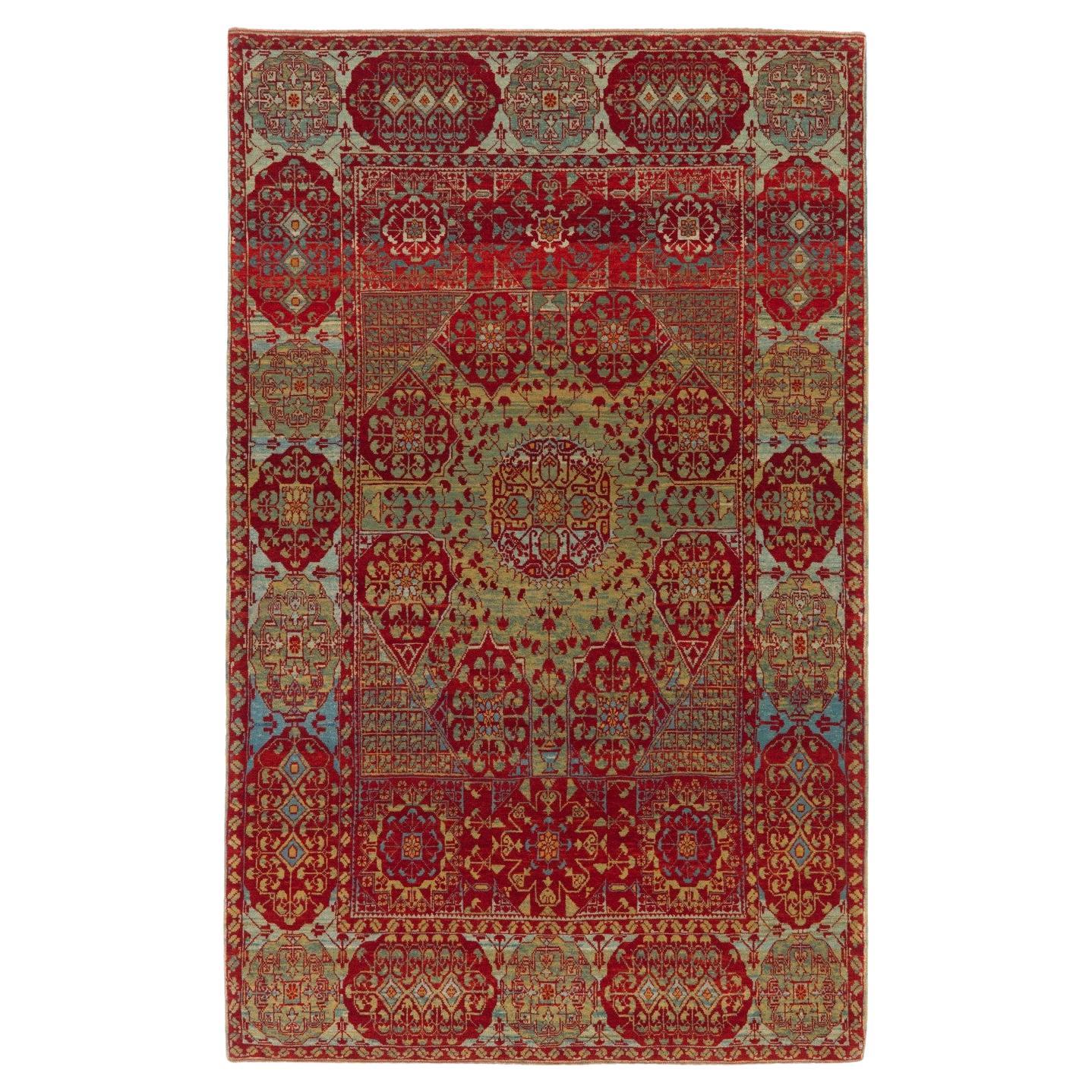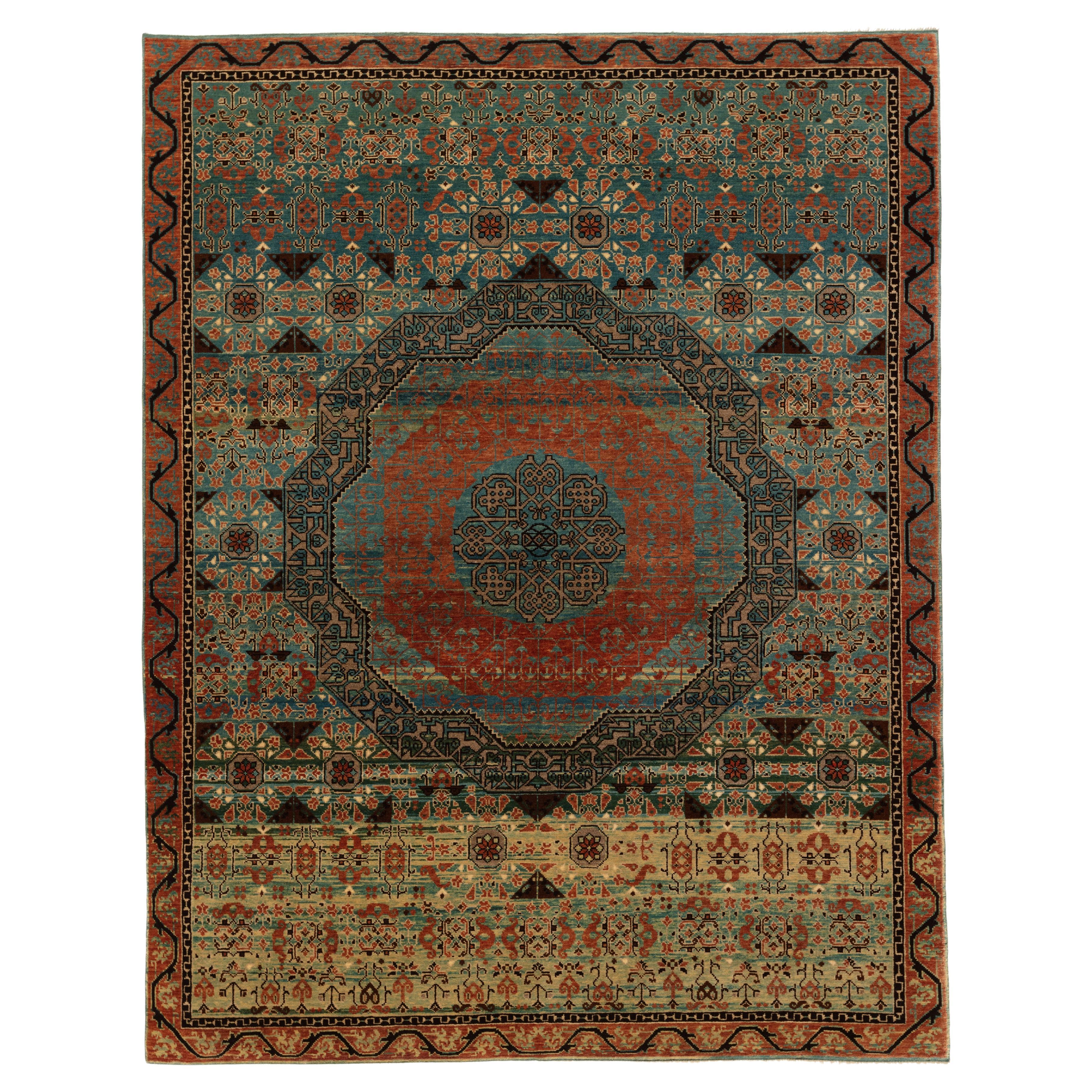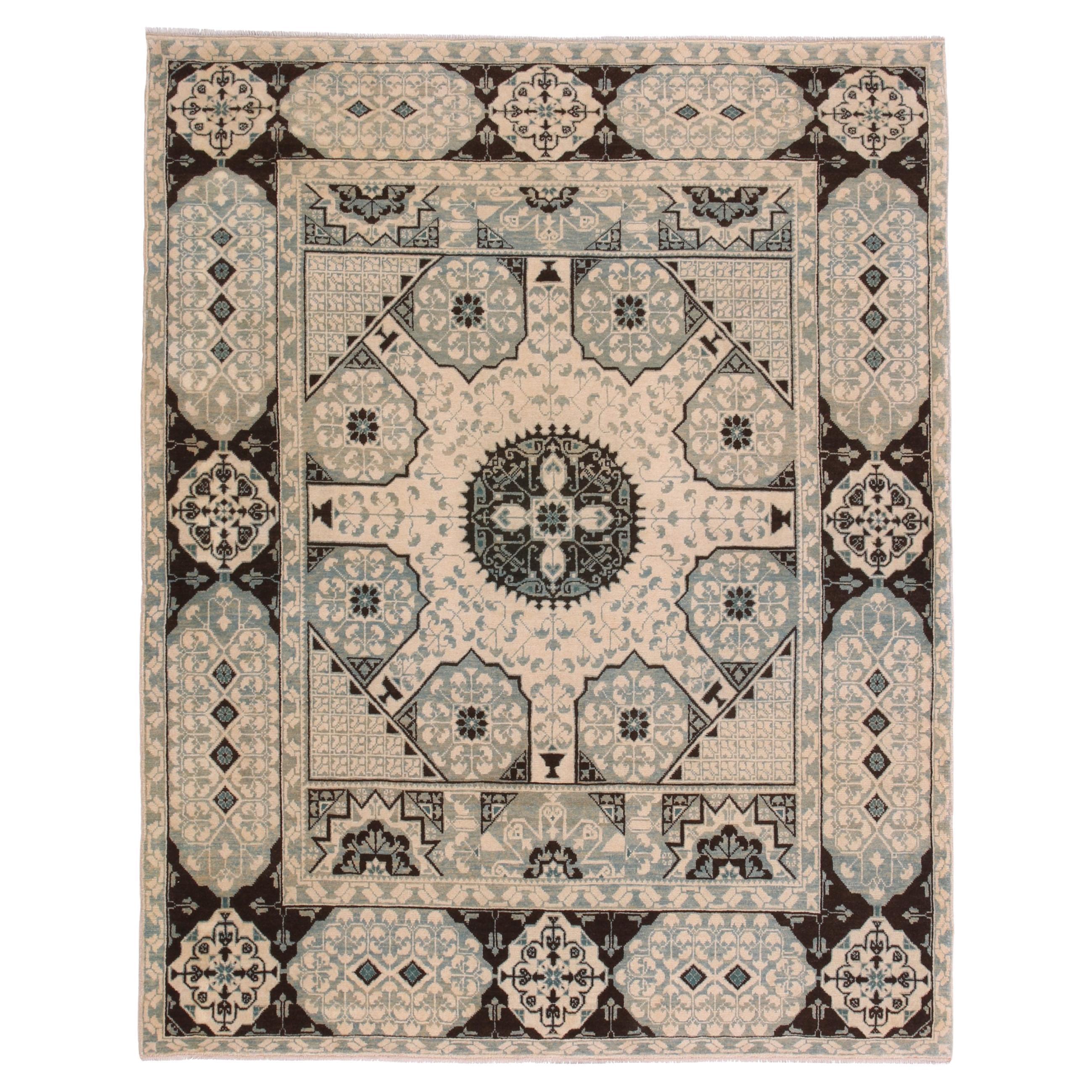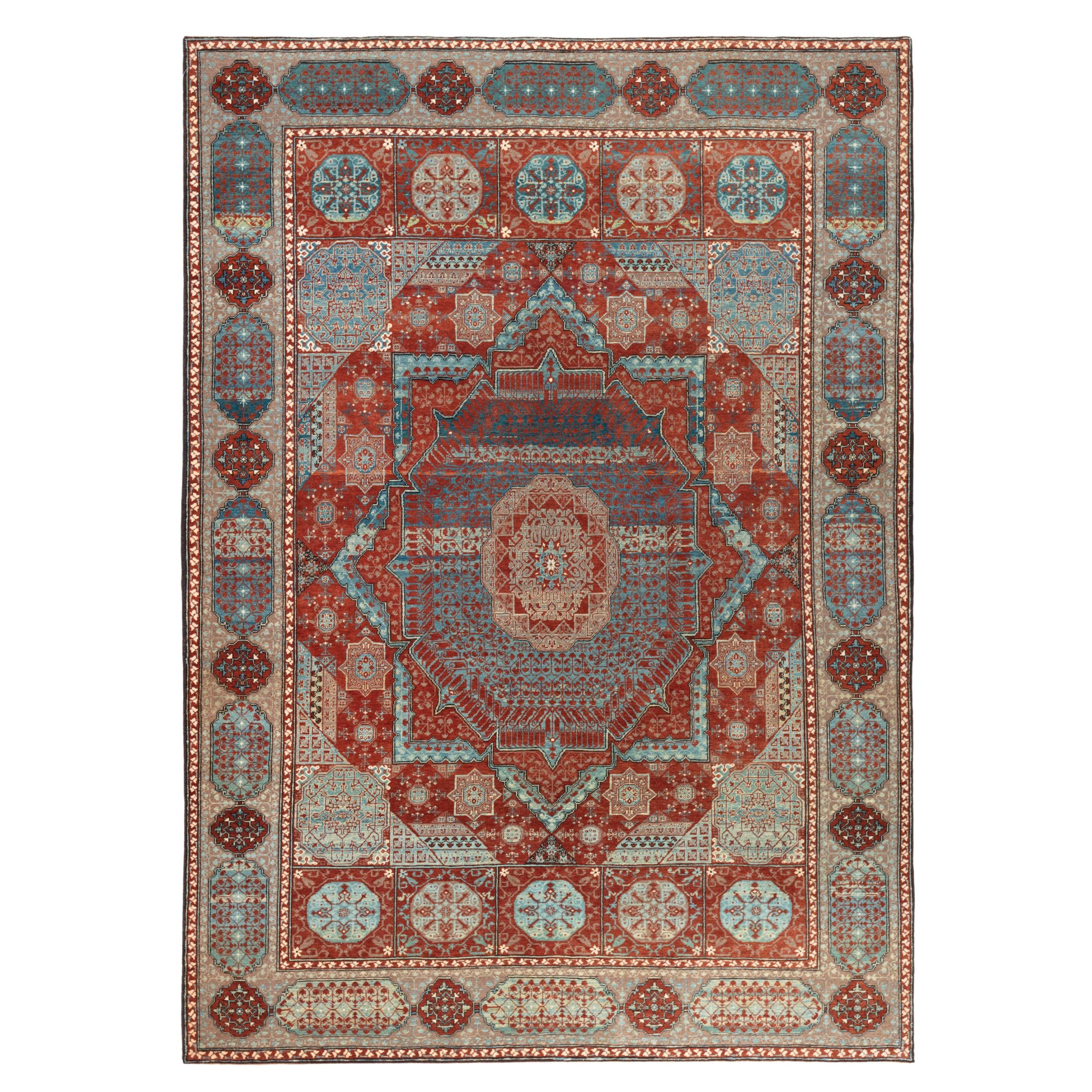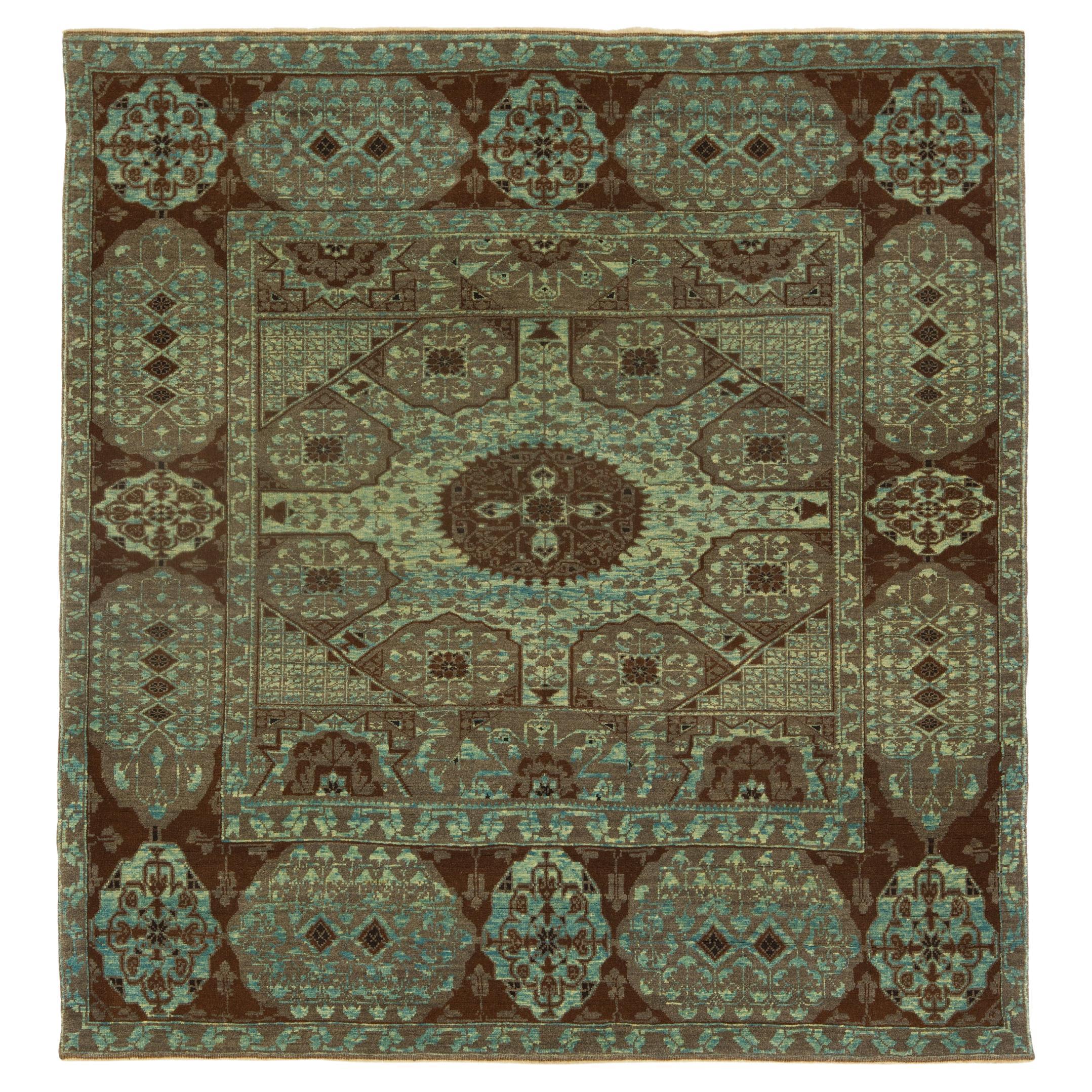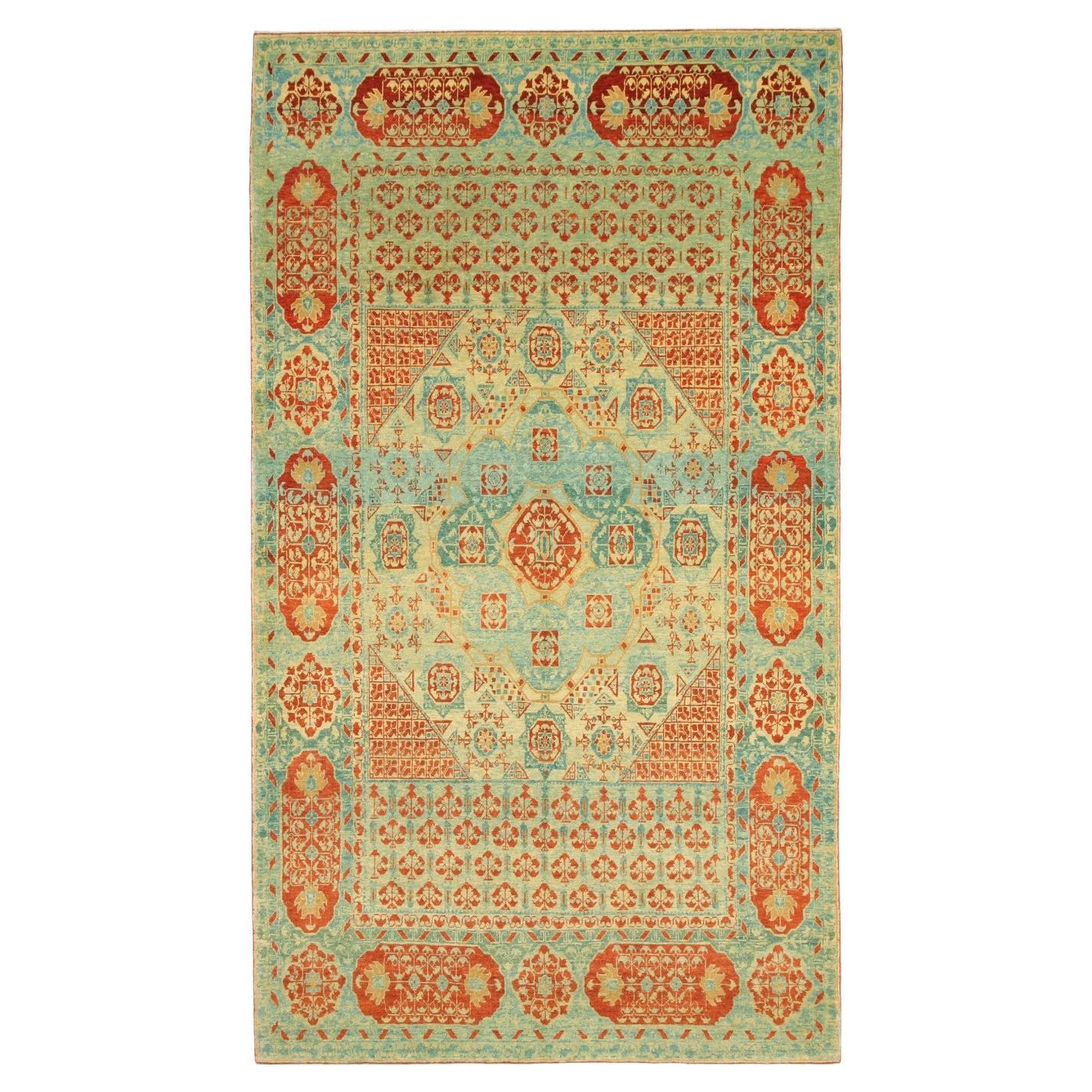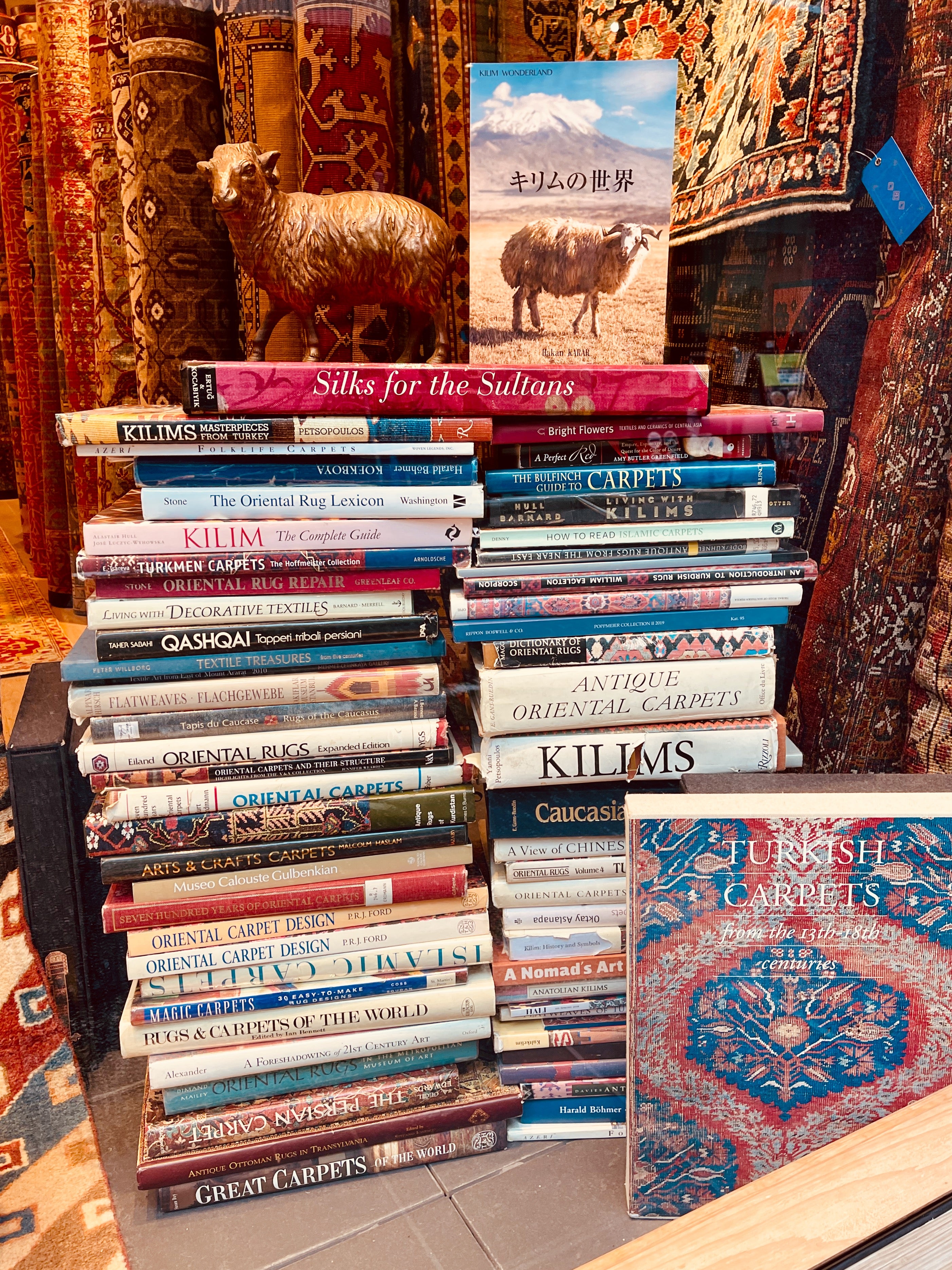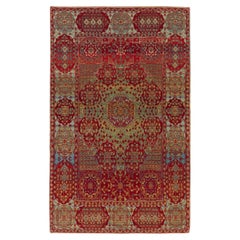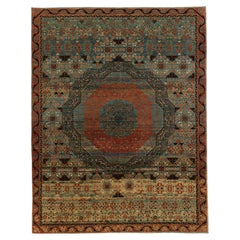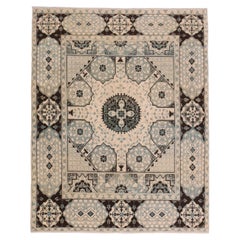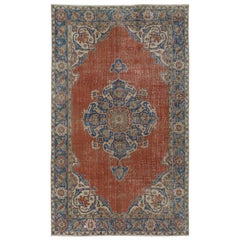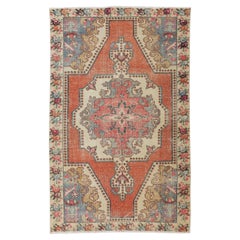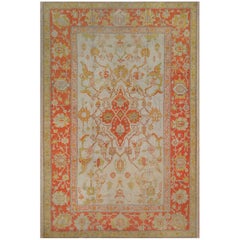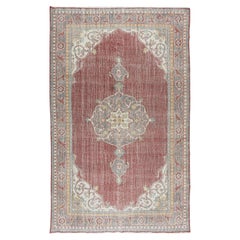Items Similar to Ararat Rugs Mamluk Carpet with Cup Motif, Antique Revival Rug, Natural Dyed
Want more images or videos?
Request additional images or videos from the seller
1 of 6
Ararat Rugs Mamluk Carpet with Cup Motif, Antique Revival Rug, Natural Dyed
$7,700
£5,842.58
€6,680.47
CA$10,754.81
A$11,957.89
CHF 6,243.75
MX$145,556.61
NOK 79,667.52
SEK 74,644.66
DKK 49,857.58
Shipping
Retrieving quote...The 1stDibs Promise:
Authenticity Guarantee,
Money-Back Guarantee,
24-Hour Cancellation
About the Item
The source of the rug comes from the book Renaissance of Islam, Art of the Mamluks, Esin Atil, Smithsonian Institution Press, Washington D.C., 1981 nr.125. This a rug with a cup motif design late 15th-century rug from Mamluk Sultane of Cairo, Egypt. It is exhibited at the Washington D.C. The Textile Museum, R.16.1.2 . The layout of this rug is characteristic of the smaller, almost square Mamluk carpet. A wide border encloses the field, divided into horizontal units consisting of a central square flanked above and below by rectangular panels. The height of the rectangular panels is approximately one-third that of the square and is equal to the width of the border. The corners of the central square are cut into triangles, creating an octagon with green ground. The octagon contains a blue polylobed medallion, which encloses an eight-pointed star with a multipetaled rosette in the core. The area between the star and the lobed medallion has floral motifs springing outward from the arms of the star. The angles of the octagon bear eight isolated and irregular polygons with a red ground; each of these units is adorned with a multipetaled rosette enclosed by a square with papyrus motifs springing from its sides and corners. The field of the octagon is filled with similar papyrus sprays, some of which appear to grow from the eight stemmed cups placed between the polygons. The triangles in the corner bear a checkerboard pattern with a stylized lotus blossom (or fleur-de-lis) in each segment. The compositional layout of the rug is reminiscent of the illuminated frontispieces, which reveal similar proportions and internal divisions. Radiating designs of geometric components filled with floral motifs are a characteristic feature of Mamluk art, as observed in manuscripts, metalwork, glass, ceramics, woodwork, and textiles of the era. The stemmed cups represented in the central square appear to have been inspired by the blazon of the saqi. Here, the cups are used as a decorative feature and cannot be identified as blazons. The same decorative motif is found on a rug in Berlin. The design of the rug is interpreted by our designers with two medallions, the most appropriate colors to match the original are used for this rug.
Color summary: 4 colors in total;
Imperial Red 426 (Madder Root)
Pale Green 439 (Chamomile - Indigo)
Cadet Blue 26 (Spurge - Indigo)
Sunray Color 405 (Henna)
Group: Islamic Rugs Family
Area: Mamluk
Material of Pile: Natural Dyed Hand-spun Wool
Material Warp / Weft: Wool on Wool
Structure: Symmetrical knot on depressed warp inclining to the right
Knots Density: 39x39
Production Place: Southeastern Anatolia – Adiyaman
Location: Tokyo KNSY
Stock: In Stock
Dimensions:
4 ft 10 in x 9 ft 10 in ( 149cm x 300cm )
- Creator:Ararat Rugs (Manufacturer)
- Dimensions:Width: 58.67 in (149 cm)Length: 118.12 in (300 cm)
- Style:Revival (In the Style Of)
- Materials and Techniques:
- Place of Origin:
- Period:
- Date of Manufacture:2022
- Production Type:New & Custom(One of a Kind)
- Estimated Production Time:Available Now
- Condition:
- Seller Location:Tokyo, JP
- Reference Number:1stDibs: LU8206237887152
ARARAT RUGS
We know and believe that the geography we come from, our past, and our lifestyle are the most important bond between us to carry the oriental carpet art and culture to the next generations along with our core values in our ongoing growth journey.
We are aware that the way to achieve this goal and carry this priceless art and culture to the future depends on a lot of work with all our people every day while adhering to our core values.
For us, art is meaningful in the sense that it brings together various cultures around the world. It is an honor for us that oriental carpet art and culture have been instrumental in this for centuries and that we are a part of this business.
We are tirelessly keeping an eye on auction house information around the world about carpets. New York's Metropolitan, London's Victoria & Albert Museums, and other famous art museums, as well as small specialized museums that house private collections, and books about oriental carpets to collect information on outstanding carpet designs and patterns from around the world. It's our Self-improving and Self-developing culture.
As Turkish Culture of Hospitality, the Kurdish Culture of Generosity, and as Japanese Culture of Business Punctuality; are the most important values that this multicultural background has taught and bequeathed to us. It is essential and valuable for us that you feel this feeling not only by looking at our oriental carpets but from the moment you contact us.
About the Seller
5.0
Platinum Seller
Premium sellers with a 4.7+ rating and 24-hour response times
Established in 1970
1stDibs seller since 2023
55 sales on 1stDibs
Typical response time: 3 hours
- ShippingRetrieving quote...Shipping from: Tokyo, Japan
- Return Policy
Authenticity Guarantee
In the unlikely event there’s an issue with an item’s authenticity, contact us within 1 year for a full refund. DetailsMoney-Back Guarantee
If your item is not as described, is damaged in transit, or does not arrive, contact us within 7 days for a full refund. Details24-Hour Cancellation
You have a 24-hour grace period in which to reconsider your purchase, with no questions asked.Vetted Professional Sellers
Our world-class sellers must adhere to strict standards for service and quality, maintaining the integrity of our listings.Price-Match Guarantee
If you find that a seller listed the same item for a lower price elsewhere, we’ll match it.Trusted Global Delivery
Our best-in-class carrier network provides specialized shipping options worldwide, including custom delivery.More From This Seller
View AllArarat Rugs Mamluk Carpet with Cup Motif, Antique Revival Rug, Natural Dyed
By Ararat Rugs
Located in Tokyo, JP
The source of the rug comes from the book Renaissance of Islam, Art of the Mamluks, Esin Atil, Smithsonian Institution Press, Washington D.C., 1981 nr.125. This a rug with a cup moti...
Category
21st Century and Contemporary Turkish Revival Turkish Rugs
Materials
Organic Material, Natural Fiber, Wool
Ararat Rugs Mamluk Rug with Cusped Medallion Antique Revival Carpet Natural Dyed
By Ararat Rugs
Located in Tokyo, JP
The source of the rug comes from the David Collection, Copenhagen. This rug with the Cusped Medallion was designed in the early 16th-century rug by the Mamluk Sultanate of Cairo, Egy...
Category
21st Century and Contemporary Turkish Revival Turkish Rugs
Materials
Wool, Natural Fiber, Organic Material
Ararat Rugs Mamluk Carpet with Cup Motif, Antique Revival Rug, Natural Dyed
By Ararat Rugs
Located in Tokyo, JP
The source of the rug comes from the book Renaissance of Islam, Art of the Mamluks, Esin Atil, Smithsonian Institution Press, Washington D.C., 1981 nr.125. This a rug with a cup motif design late 15th-century rug from Mamluk Sultane of Cairo, Egypt. It is exhibited at the Washington D.C. The Textile Museum, R.16.1.2 . The layout of this rug is characteristic of the smaller, almost square Mamluk carpet. A wide border encloses the field, divided into horizontal units consisting of a central square flanked above and below by rectangular panels. The height of the rectangular panels is approximately one-third that of the square and is equal to the width of the border. The corners of the central square are cut into triangles, creating an octagon with green ground. The octagon contains a blue polylobed medallion, which encloses an eight-pointed star with a multipetaled rosette in the core. The area between the star and the lobed medallion has floral motifs springing outward from the arms of the star. The angles of the octagon bear eight isolated and irregular polygons with a red ground; each of these units is adorned with a multipetaled rosette enclosed by a square with papyrus motifs springing from its sides and corners. The field of the octagon is filled with similar papyrus sprays, some of which appear to grow from the eight stemmed cups placed between the polygons. The triangles in the corner bear a checkerboard pattern with a stylized lotus blossom (or fleur-de-lis) in each segment. The compositional layout of the rug is reminiscent of the illuminated frontispieces, which reveal similar proportions and internal divisions. Radiating designs of geometric components filled with floral motifs are a characteristic feature of Mamluk art...
Category
21st Century and Contemporary Turkish Revival Turkish Rugs
Materials
Wool, Natural Fiber, Organic Material
Ararat Rugs the Simonetti Mamluk Carpet 16th Century Revival Rug, Natural Dyed
By Ararat Rugs
Located in Tokyo, JP
The source of carpet comes from the book How to Read – Islamic Carpets, Walter B. Denny, The Metropolitan Museum of Art, New York 2014 fig.61,62. The five-star-medallion carpet was d...
Category
21st Century and Contemporary Turkish Revival Turkish Rugs
Materials
Wool, Natural Fiber, Organic Material
Ararat Rugs Mamluk Carpet with Cup Motif, Antique Revival Rug, Natural Dyed
By Ararat Rugs
Located in Tokyo, JP
The source of the rug comes from the book Renaissance of Islam, Art of the Mamluks, Esin Atil, Smithsonian Institution Press, Washington D.C., 1981 nr.125. This is a rug with a cup motif design late 15th-century rug from the Mamluk Sultanate of Cairo, Egypt. It is exhibited at the Washington, D.C. The Textile Museum, R.16.1.2 . The layout of this rug is characteristic of the smaller, almost square Mamluk carpet. A wide border encloses the field, divided into horizontal units consisting of a central square flanked above and below by rectangular panels. The height of the rectangular panels is approximately one-third that of the square and is equal to the width of the border. The corners of the central square are cut into triangles, creating an octagon with green ground. The octagon contains a blue polylobed medallion, which encloses an eight-pointed star with a multipetaled rosette in the core. The area between the star and the lobed medallion has floral motifs springing outward from the arms of the star. The angles of the octagon bear eight isolated and irregular polygons with a red ground; each of these units is adorned with a multipetaled rosette enclosed by a square with papyrus motifs springing from its sides and corners. The field of the octagon is filled with similar papyrus sprays, some of which appear to grow from the eight-stemmed cups placed between the polygons. The triangles in the corners bear a checkerboard pattern with a stylized lotus blossom (or fleur-de-lis) in each segment. The compositional layout of the rug is reminiscent of the illuminated frontispieces, which reveal similar proportions and internal divisions. Radiating designs of geometric components filled with floral motifs are a characteristic feature of Mamluk art...
Category
21st Century and Contemporary Turkish Revival Turkish Rugs
Materials
Wool, Natural Fiber, Organic Material
Ararat Rugs The Simonetti Mamluk Carpet 16th C. Revival Rug, Square Natural Dyed
By Ararat Rugs
Located in Tokyo, JP
The source of carpet comes from the book How to Read - Islamic Carpets, Walter B. Denny, The Metropolitan Museum of Art, New York 2014 fig.61,62. The five-star-medallion carpet was d...
Category
21st Century and Contemporary Turkish Revival Turkish Rugs
Materials
Wool, Natural Fiber, Organic Material
You May Also Like
5.5x9.2 Ft Hand knotted Vintage Turkish Wool Area Rug with Medallion Design
Located in Spring Valley, NY
Infuse your home with the timeless beauty of this traditional vintage handmade Turkish rug, a hand-knotted masterpiece crafted from a luxurious blend of wool and cotton. Woven by ski...
Category
Vintage 1960s Turkish Rustic Turkish Rugs
Materials
Wool, Cotton
$880 Sale Price
30% Off
Free Shipping
Vintage Hand Knotted Turkish Wool Rug, One-of-a-kind Geometric Carpet
Located in Spring Valley, NY
A vintage Turkish rug. Finely hand knotted with even medium wool pile on wool foundation. Very good condition. Sturdy and as clean as a brand new rug (deep was...
Category
Mid-20th Century Turkish Tribal Turkish Rugs
Materials
Wool
$621 Sale Price
40% Off
Hand-Woven Antique Late 19th Century Wool Turkish Oushak Rug
Located in West Hollywood, CA
The ivory field with a central tomato-red cusped medallion issuing angular palmette and flower head vine, in a broad tomato-red border containing sandy-yellow and ivory palmette vine between ivory meandering floral vine stripes, plain outer ivory stripe.
About Antique Oushak Rugs: Oushak (or Ushak) rugs originate from the small town of Oushak in west-central Anatolia, which is located just south of modern-day Istanbul, Turkey. Oushak has been a center of production for Turkish rugs since the beginning of the Ottoman Empire...
Category
Antique Late 19th Century Turkish Oushak Turkish Rugs
Materials
Wool
Hand Knotted Vintage Turkish Wool Area Rug, Medallion Design Carpet
Located in Spring Valley, NY
A finely hand-knotted vintage Turkish carpet from 1960s featuring an elegant medallion design. The rug has even low wool pile on cotton foundation. It is heavy and lays flat on the f...
Category
Mid-20th Century Turkish Oushak Turkish Rugs
Materials
Wool, Cotton
$945 Sale Price
30% Off
Vintage Turkish Decorative Oriental Oushak Rug in Runner Size
Located in New York, NY
Vintage Turkish Oushak Decorative Oriental Carpet, Runner size, with Soft red Field
A gorgeous vintage Turkish Oushak carpet, circa 1950, size 5'5" x 2'10". This lovely carpet fea...
Category
Vintage 1950s Turkish Central Asian Rugs
Materials
Wool
$636 Sale Price
20% Off
6.3x9.7 Ft Vintage Turkish Kysari Rug. Fine, Timeless Classic Oriental Carpet
Located in Spring Valley, NY
Add a touch of timeless elegance to your home with this traditional vintage hand knotted Turkish area rug, crafted from 100% premium wool. This exquisite piece captures the essence o...
Category
Vintage 1960s Turkish Rustic Turkish Rugs
Materials
Wool
$2,360 Sale Price
20% Off
Free Shipping
More Ways To Browse
Book Divider
Renaissance Cups
Antique Egyptian Glass
Glass Panel Room Divider
Islamic Manuscript
Islamic Illuminated Manuscript
Art Deco Mid Century Coffee Table
Arts And Crafts Carved Table
Lounge Chair With Stool
Sterling Silver Sterling Silver Tea Service
Sterling Tea Service
Succession Furniture
The Egg Chair
Tiffany Chair
19th Century French Gothic Furniture
American Georgian Furniture
Antique Floral Engraving
Cane Top Table
